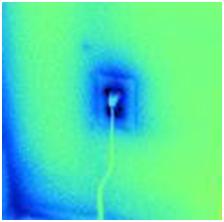Tightening Up Your Home

Did you know that in the average home, about half of the energy consumed is wasted? There are a number of contributors to this phenomenon, including inefficient lighting & appliances and bad habits, but the main culprit is the shell of your home. Your biggest energy expense it heating and cooling your home, so the more you can do to minimize heat transfer, the less work your furnace and air conditioner have to do.
Many homebuilders are now much more aware of the importance of creating a tight building envelope, and some homes are so tight that they need a ventilation system to bring in fresh air. But if you’re in an older home, you probably have the equivalent of a two- or three-foot square window open, bringing heat inside in the summer and letting it out in the winter. This hole is the sum total of all of the poor seals around doors, windows, pipes, ductwork and electrical outlets. There are a variety of ways to seal these leaks, including caulk, weatherstripping and expanding foam. This is an important first step in tightening up your home.
In addition to the leaks, many homes are poorly insulated. Since heat rises, you stand to lose a lot of heat through the ceiling if it’s not well insulated. It’s fairly economical to have additional insulation applied if you have open attic space, with blown-in cellulose being the most common approach. Putting 12-14 inches of insulation will provide a nice blanket to keep your home warm in the winter, and act like a pot-holder in the summer to keep the heat from the attic from cooking your living space. The payback on this project is very attractive – your energy savings will usually cover the cost of the retrofit in a year or two.
Adding more insulation to your walls is a bit trickier and more expensive. This process may be cost-prohibitive, because the payback is often 15 years or more. Blown-in cellulose can be injected into wall cavities between studs and around existing fiberglass insulation to improve your R value by 30-50 percent. A 2-3 inch hole is drilled in about a foot or two from the floor, and the insulation is applied through flexible tubing up into the wall. GreenSpace Construction (www.GreenSpaceConstruct.com) offers a free inspection and estimate to provide you with options to pick the low-lying fruit.
Spray foam is great for both air sealing and insulation, and is a good moisture barrier too. If you have an unfinished basement, you can spray the rafters with foam, including pipes and ductwork, to form a comfortable barrier between this and your conditioned space. If you want to finish a basement, foam is the best way to insulate the room from the concrete foundation.
If you’re considering a significant rehab project that includes replacing household wiring, you could consider using expanding foam to insulate exterior walls. To do this, they actually cut out a portion of the wall (usually about 18 inches) all around the inside perimeter of the home, remove any existing fiberglass insulation, and then spray in the foam to fill the space between studs. This process is expensive, but provides excellent insulation.
While a good do-it-yourselfer can do any number of these things alone, a professional energy audit will provide you with a comprehensive assessment and strategy for making your home energy efficient. Companies like Home Green Home (www.HomeGreenHome.us) have professional auditors with a variety of tools to identify leaks, insulation gaps, and other inefficiencies in your home. The standard method to measure the air-tightness of your home is to use the blower-door test. This is essentially a fan that is temporarily fitted to an exterior door, pulling air out to create a vacuum which draws air in through leaks in the home. A pressure gauge calibrates the number of air changes per hour (ACH) to determine the overall air-tightness of your home. The auditor may also use a smoke pencil to identify the primary source of the leaks.
Another tool commonly used by energy auditors is the thermal imaging camera. This device is used to measure surface temperatures on exterior walls, ceilings, doors and windows using infrared technology. The result is an image that shows the heat spectrum of the surface, with cooler temperatures in purple, blue and green and warmer colors in yellow, orange and red. These images provide very clear evidence of the leaks and poor insulation.
The most inexpensive energy is energy not used, and the HomeStar (aka Cash for Caulkers) program promises to make these kinds of upgrades more affordable, and put Americans back to work in the process. If you haven’t already, take steps to tighten up your home’s exterior so your HVAC equipment doesn’t have to work as long or hard. You’ll appreciate the more even, comfortable temperatures, and of course save money on lower utility bills.
This was published in the Going Green section of the July 2010 issue of Spirit Seeker magazine.

0 Comments